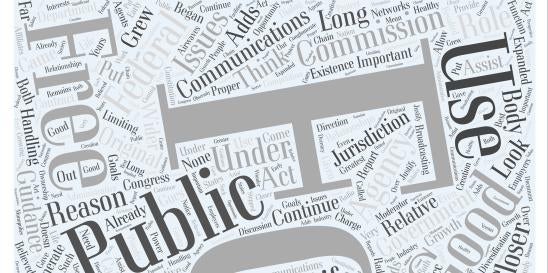After more than three years of consideration, amidst the largest federal and state investment in broadband deployment, and anticipating disputes between broadband providers and utility pole owners concerning the terms and conditions of new attachments particularly in broadband expansion areas, the Federal Communications Commission (“FCC”) has released a new pole-attachment order If adopted, the order would dramatically reform the Commission’s rules and policies governing communications attachments to utility poles.
Set for a vote at the FCC’s December 13th, 2023 open meeting, and assuming that the draft order is adopted more or less in its current form (which we expect), the order will introduce entirely new and expedited procedures for the processing of pole access complaints, as well as new restrictions associated with pole owners’ recovery of pole-replacement costs that communications attacher raised more than three years ago. The order also introduces additional pole-owner outside plant disclosure obligations intended to facilitate broadband deployment.
Paradoxically, however, the proposed order rejects communications attacher proposals to secure financial and other outside plant data elements (that pole owners track in the normal course) necessary for the calculation of pole attachment rates under the FCC’s pole rate formula.
According to the Commission, the order contains “additional steps to speed broadband deployment by making the pole attachment process faster, more transparent, and more cost effective.”
First among these is the creation of a new intra-agency (and multi-bureau) “rapid response team” to resolve pole attachment disputes that “impede or delay broadband deployment.” Dubbing this new access dispute team the “Rapid Broadband Assessment Team” (“RBAT”), the FCC borrowed heavily from Maine Public Utility Commission rules. The new FCC RBAT rules, among other things, provide summary procedures expediting FCC staff engagement to address pole-access disputes, including through face-to-face meetings between parties, mediation, and possible referral for hearing to an administrative law judge.
With respect to pole replacements costs, the FCC ruling seeks to clarify (i) what constitutes a “red tagged” pole (i.e., one that the utility already plans to replace for reasons other than lack of capacity to fit a new attachment) and (ii) when pole replacements are not “necessitated solely” by a third party’s attachment or modification request.
The FCC’s draft order also contains a further notice of proposed rulemaking seeking comment on measures intended to better facilitate high-volume pole attachment applications and make-ready.
If approved, the new rules would apply to poles owned by investor-owned utilities in the 27 states that currently adhere to FCC rules regarding pole attachment rates, terms, and conditions. But even in states that have “reverse preempted” the FCC’s pole attachment rules, these new rules and declaratory order still likely will influence state-level efforts to reform pole attachment processes in order to facilitate broadband build-outs, especially in rural and unserved areas.
Additional detail from the FCC’s draft order includes:
Speeding Pole Attachment Dispute Resolution
- The FCC’s new RBAT is meant to “expedite the resolution of pole attachment disputes that are alleged to impede or delay the deployment of broadband facilities and to provide coordinated review and assessment of such disputes.” This process is similar to the “Rapid Response Process” used by the Maine Public Utilities Commission.
- The RBAT – to be comprised of staff from the FCC’s Enforcement Bureau and Wireline Competition Bureau – will promptly review all pertinent information by the parties and recommend a process for resolving disputes, including mediation, use of the FCC’s Accelerated Docket (which adjudicates issues in under 60 days), and/or other appropriate action.
- To request RBAT review, a party must first notify the Chief of the Enforcement Bureau’s Market Disputes Resolution Division by phone and in writing, after which the party will have to complete an online form detailing the dispute. From there, the RBAT will schedule a meeting with all parties “as soon as practicable” and may also request a written response from the other party. At the initial meeting(s), the RBAT will recommend what it deems the most effective method to resolve the dispute.
- The RBAT will have discretion to decide whether a dispute (or portions of it) is suitable for the Accelerated Docket based on the totality of several criteria, including whether the prospective complainant states a claim under the Communications Act or FCC rules; whether resolution of the dispute will advance broadband deployment especially in an unserved or underserved area; whether the parties have exhausted all reasonable settlement and mediation opportunities; and the number and complexity of the issues and need for discovery. If the case goes to the Accelerated Docket, it will be resolved by the Commission’s Administrative Law Judge in an expedited “minitrial.”
Providing Utility Pole Inspection Information
- The FCC’s new rules would require a utility to provide attachment applicants, upon request, information contained in the utility’s most recent cyclical pole inspection reports (any report that the utility creates in the normal course of business containing the results of a routine inspection of poles) for the poles covered by the attacher’s application. The utility must furnish the report within 10 business days of the request.
- Utilities also will be required to retain copies, in whatever form they were created, of their pole inspection reports until a new report is created.
- The FCC explained that requiring utilities to provide this information about the state of their poles is a “transparency measure” meant to “help improve the attachment process and potentially reduce disputes.”
- The FCC declined, however, to require utilities to create online pole-information databases or to provide other records such as financial data regarding pole costs, load studies, or data on the age, height, class, and condition of poles. The FCC explained that there are several other ways to obtain that information, including through the new dispute resolution process.
Declaratory Ruling on Pole Replacement Costs
- Consistent with Section 224(h) of the Communications Act, the FCC’s current rules provide that when a pole modification, such as a pole replacement, is conducted for the benefit of a particular party, then the benefiting party must assume the costs.
- The existing rule (47 C.F.R. § 1.1408(b)) similarly prevents pole owners from shifting pole replacement costs onto an attacher if the new pole is not “necessitated solely” by an additional attachment.
- The question of allocating pole replacement costs between pole owners and attachers is not new, but is hotly contested.
- Beginning with a 2020 petition for declaratory ruling, communications providers have asserted that (i) utilities have unfairly passed onto them the entire cost of pole replacements and upgrades, even when certain poles already were due to be replaced for safety reasons; and (ii) this long-standing reflexive cost shift is an acute barrier to broadband development, especially in unserved areas of the country, where costs of construction can be higher.
- Utilities, however, have said that they normally would not replace many of the poles at issue, but for an attacher’s request.
- The FCC’s declaratory ruling would expand the Commission’s definition of “red tagged” poles, which under current FCC rules, new attachers are not responsible for pole replacement costs.
- While the FCC previously defined red-tagged poles as being non-compliant with safety standards and already set for replacement, the updated definition would be “poles that the utility identifies for replacement for any reason other than the pole’s lack of capacity to accommodate a new attachment.”
- According to the FCC, the old definition was “too restrictive,” but the new definition better accords with cost causation and cost allocation principles.
- The FCC’s declaratory ruling also clarifies the phrase “necessitated solely” in 47 C.F.R. § 1.1408(b) with examples of when a pole replacement is not “necessitated solely” by an attachment request.
- These include (1) when a pole replacement is required by applicable law; (2) the current pole fails engineering standards; or (3) the pole already is on a utility’s replacement schedule.
- The Commission also makes clear that when a defective pole needs to be replaced with a taller pole to support a new attachment, then the attacher need only pay for the incremental extra cost a taller/stronger pole—not the full cost of an equivalent pole.
Given the impact of pole replacement costs on broadband buildouts, several states have also taken steps in the last few months to help address cost allocation. For example, North Carolina has appropriated $100 million in Federal American Rescue Plan Act funding for a pole replacement cost reimbursement program to reimburse up to up to 50% of eligible pole replacement costs paid by qualified broadband providers in unserved areas or $10,000, whichever is less for each pole replacement.
And, in early November, Texas passed a state constitutional amendment to create a $1.5 billion Broadband Infrastructure Fund for matching federal grants, one purpose of which will be to reimburse up to the lesser of $5,000 or 50% of pole replacement costs. Additionally, Ohio recently allocated $50 million to help defray qualifying pole replacement or mid-span pole installation costs, allowing applicants to seek reimbursement for the lesser of $7,500 or 75% of the total cost per pole.
Further Rulemaking On Pole Attachment Applications and Make-Ready
- Through further notice of proposed rulemaking (“FNPRM”), the FCC will seek comment on further actions to facilitate the processing of pole attachment applications that are submitted in large orders (such as requests exceeding 3,000 poles). For example, the Commission seeks input on a proposal to prohibit utilities from limiting the size of an application or the number of poles included in an application.
- The FCC also seeks comment on whether it should modify its rules to enable attachers to access poles more quickly through “self help” when utilities fail to conduct pole attachment surveys, estimates, or prepare poles for attachments within the FCC’s required “make-ready” time periods.
- The FCC further seeks comment on the impact of contractor availability when attachers seek to use their own contractors when conducting self help or one-touch make-ready for surveys and make-ready work.
Next Steps
If the Commission adopts the draft report and order, as expected, these new rules will go into effect 30 days after publication in the Federal Register. The declaratory ruling would take effect immediately upon publication. Also, although it is unlikely to delay the new rules’ effective date, pole owners are sure to challenge the new rules in court.
Finally, the FNPRM, when adopted, will set comment deadlines for interested parties in WC Docket No. 17-84.







 i
i


